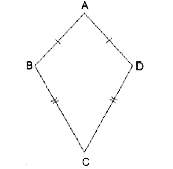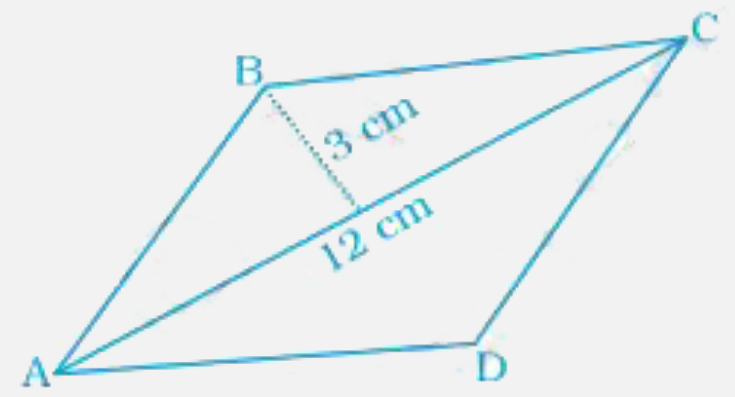Let ABCD be a kite in which AB =AD and BC=DC.Then, kite ABCD is symmetrical about the diagonal AC .true or false?
To determine whether kite ABCD is symmetrical about the diagonal AC, we can follow these steps:
1. Understanding the Properties of a Kite:
- A kite is a quadrilateral with two distinct pairs of adjacent sides that are equal. In this case, we have AB = AD and BC = DC.
2. Identifying the Diagonal:
- The diagonal AC divides the kite into two triangles: triangle ABC and triangle ADC.
3. Analyzing Symmetry:
- For a figure to be symmetrical about a line (in this case, diagonal AC), one half of the figure must be a mirror image of the other half when folded along that line.
- Since AB = AD and BC = DC, the triangles ABC and ADC are congruent by the Side-Side-Side (SSS) postulate of congruence.
4. Conclusion on Symmetry:
- Because triangles ABC and ADC are congruent, they are mirror images of each other across diagonal AC. This means that kite ABCD is symmetrical about diagonal AC.
5. Final Answer:
- Therefore, the statement that kite ABCD is symmetrical about the diagonal AC is True.
- A kite is a quadrilateral with two distinct pairs of adjacent sides that are equal. In this case, we have AB = AD and BC = DC.
- The diagonal AC divides the kite into two triangles: triangle ABC and triangle ADC.
- For a figure to be symmetrical about a line (in this case, diagonal AC), one half of the figure must be a mirror image of the other half when folded along that line.
- Since AB = AD and BC = DC, the triangles ABC and ADC are congruent by the Side-Side-Side (SSS) postulate of congruence.
- Because triangles ABC and ADC are congruent, they are mirror images of each other across diagonal AC. This means that kite ABCD is symmetrical about diagonal AC.
- Therefore, the statement that kite ABCD is symmetrical about the diagonal AC is True.
Topper's Solved these Questions
- REFLECTION AND ROTATIONAL SYMMETRYBook:RS AGGARWALChapter:REFLECTION AND ROTATIONAL SYMMETRYExercise:Exercise A(MCQ)
Explore 10 Videos
- REFLECTION AND ROTATIONAL SYMMETRYBook:RS AGGARWALChapter:REFLECTION AND ROTATIONAL SYMMETRYExercise:Exercise A(True / False)
Explore 7 Videos
- RATIONAL NUMBERSBook:RS AGGARWALChapter:RATIONAL NUMBERSExercise:TEST PAPER -(4)
Explore 17 Videos
- SIMPLE INTEREST Book:RS AGGARWALChapter:SIMPLE INTEREST Exercise:test perper 12 D
Explore 1 Video
Similar Questions
Knowledge Check
ABCD is a kite in which AB=AD and BC= DC.
The kite is symmetrical about
 Athe diagonal ACBthe diagonal BDCnone of theseDboth (a) and (d)
Athe diagonal ACBthe diagonal BDCnone of theseDboth (a) and (d)ABCD is a trapezium in which AB∣∣CD and AB=2CD. It its diagonals intersect each other at O then ratio of the area of triangle AOB and COD is
A1:2B2:1C4:1D1:4A kite has one line of symmetry. true or false?
Athe diagonal ACBthe diagonal BDCnone of theseDAll of the above
The figure ABCD is a quadrilateral in which AB = CD and BC = AD. Its area is

View SolutionABCD is a kite in which AB=AD and CB=CD. If ∠ABD=25∘and∠BDC=35∘, then find ∠A−∠C.
View SolutionABCD is a kite in which AB=AD and CB=CD. If ∠ABD=30∘and∠BDC=40∘, then find ∠A+∠C.
View SolutionIn the given figure, quadrilateral ABCD is a quadrilateral in which AB = AD and BC = DC. Prove that (i) AC bisects ∠A and ∠B, (ii) AC.is the perpendicular bisector of BD.
View SolutionABCD is a quadrilateral in which AB=CD and AD=BC. show that it is a parallelogram.
View Solution